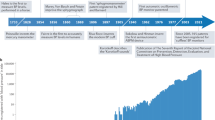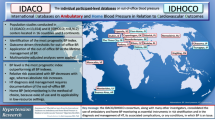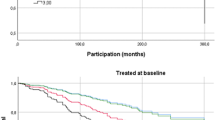Abstract
It is well known that 24-h ambulatory blood pressure monitoring (ABPM) provides a more accurate picture of a patient’s blood pressure (BP) compared with clinic BP measurement. Twenty-four-hour ABPM better predicts hypertension-related risks such as end-organ damage including left ventricular hypertrophy, cardiovascular (CV) events and mortality. Threshold BP values for hypertension based on 24-h ABPM results have been established, including daytime and night-time averages. Nevertheless, the relationship between 24-h ABPM and clinic BP measurement in patients on antihypertensive therapy, and in particular how each may change in response to antihypertensive therapy, is less clear. This review will provide an overview of current knowledge on the relation between clinic BP and ambulatory BP reductions in clinical trials on antihypertensive therapies. Reduction in CV risk and its correlation with the magnitude of reduction in both clinic and ambulatory BP are explored. The most striking result is that reduction in clinic BP and ambulatory BP do not correspond in a 1:1 fashion, that is, smaller changes in 24-h ABPM correspond to significantly larger changes in clinic BP.
This is a preview of subscription content, access via your institution
Access options
Subscribe to this journal
Receive 12 digital issues and online access to articles
$119.00 per year
only $9.92 per issue
Buy this article
- Purchase on Springer Link
- Instant access to full article PDF
Prices may be subject to local taxes which are calculated during checkout




Similar content being viewed by others
References
Clement DL, De Buyzere ML, De Bacquer DA, de Leeuw PW, Duprez DA, Fagard RH et al. Prognostic value of ambulatory blood-pressure recordings in patients with treated hypertension. N Engl J Med 2003; 348 (24): 2407–2415.
Dolan E, Stanton A, Thijs L, Hinedi K, Atkins N, McClory S et al. Superiority of ambulatory over clinic blood pressure measurement in predicting mortality: the Dublin outcome study. Hypertension 2005; 46 (1): 156–161.
Minutolo R, Agarwal R, Borrelli S, Chiodini P, Bellizzi V, Nappi F et al. Prognostic role of ambulatory blood pressure measurement in patients with nondialysis chronic kidney disease. Arch Intern Med 2011; 171 (12): 1090–1098.
Fagard RH, Staessen JA, Thijs L. . Relationships between changes in left ventricular mass and in clinic and ambulatory blood pressure in response to antihypertensive therapy. J hypertens 1997; 15 (12 Pt 1): 1493–1502.
Staessen JA, Thijs L, Fagard R, O'Brien ET, Clement D, de Leeuw PW et al. Predicting cardiovascular risk using conventional vs ambulatory blood pressure in older patients with systolic hypertension. Systolic Hypertension in Europe Trial Investigators. JAMA 1999; 282 (6): 539–546.
Krause T, Lovibond K, Caulfield M, McCormack T, Williams B. . Management of hypertension: summary of NICE guidance. BMJ 2011; 343: d4891.
Mancia G, De Backer G, Dominiczak A, Cifkova R, Fagard R, Germano G et al2007 Guidelines for the management of arterial hypertension: The Task Force for the Management of Arterial Hypertension of the European Society of Hypertension (ESH) and of the European Society of Cardiology (ESC). Eur Heart J 28 (12): 1462–1536.
Head GA, McGrath BP, Mihailidou AS, Nelson MR, Schlaich MP, Stowasser M et al. Ambulatory blood pressure monitoring in Australia: 2011 consensus position statement. J Hypertens 2012; 30 (2): 253–266.
Hansson L, Zanchetti A, Carruthers SG, Dahlof B, Elmfeldt D, Julius S et al. Effects of intensive blood-pressure lowering and low-dose aspirin in patients with hypertension: principal results of the Hypertension Optimal Treatment (HOT) randomised trial. HOT Study Group. Lancet 1998; 351 (9118): 1755–1762.
Cushman WC, Evans GW, Byington RP, Goff DC Jr, Grimm RH Jr, Cutler JA et al. Effects of intensive blood-pressure control in type 2 diabetes mellitus. N Engl J Med 2010; 362 (17): 1575–1585.
UK Prospective Diabetes Study Group. Tight blood pressure control and risk of macrovascular and microvascular complications in type 2 diabetes: UKPDS 38. BMJ 1998; 317 (7160): 703–713.
de la Sierra A, Segura J, Banegas JR, Gorostidi M, de la Cruz JJ, Armario P et al. Clinical features of 8295 patients with resistant hypertension classified on the basis of ambulatory blood pressure monitoring. Hypertension 2011; 57 (5): 898–902.
Gorostidi M, Sobrino J, Segura J, Sierra C, de la Sierra A, Hernandez del Rey R et al. Ambulatory blood pressure monitoring in hypertensive patients with high cardiovascular risk: a cross-sectional analysis of a 20,000-patient database in Spain. J Hypertens 2007; 25 (5): 977–984.
Puchades R, Ruiz-Nodar JM, Blanco F, Rodriguez F, Gabriel R, Suarez C. . White-coat hypertension in the elderly. Echocardiographic analysis. A substudy of the EPICARDIAN project. Rev Esp Cardiol 2010; 63 (11): 1377–1381.
Fagard RH, Cornelissen VA . Incidence of cardiovascular events in white-coat, masked and sustained hypertension versus true normotension: a meta-analysis. J Hypertens 2007; 25 (11): 2193–2198.
Franklin SS, Thijs L, Hansen TW, Li Y, Boggia J, Kikuya M et al. Significance of white-coat hypertension in older persons with isolated systolic hypertension: a meta-analysis using the International Database on Ambulatory Blood Pressure Monitoring in Relation to Cardiovascular Outcomes population. Hypertension 2012; 59 (3): 564–571.
Lehmann MV, Zeymer U, Dechend R, Kaiser E, Hagedorn I, Deeg E et al. Ambulatory blood pressure monitoring: is it mandatory for blood pressure control in treated hypertensive patients? Int J Cardiol 2013; 13: 00269–6 accepted.
Bjorklund K, Lind L, Zethelius B, Andren B, Lithell H. . Isolated ambulatory hypertension predicts cardiovascular morbidity in elderly men. Circulation 2003; 107 (9): 1297–1302.
Ogedegbe G, Agyemang C, Ravenell JE. . Masked hypertension: evidence of the need to treat. Curr Hypertens Rep 2010; 12 (5): 349–355.
Bobrie G, Clerson P, Menard J, Postel-Vinay N, Chatellier G, Plouin PF. . Masked hypertension: a systematic review. J Hypertens 2008; 26 (9): 1715–1725.
Pierdomenico SD, Cuccurullo F. . Prognostic value of white-coat and masked hypertension diagnosed by ambulatory monitoring in initially untreated subjects: an updated meta analysis. Am J Hypertens 2011; 24 (1): 52–58.
Bidani AK, Griffin KA, Epstein M. . Hypertension and chronic kidney disease progression: why the suboptimal outcomes? Am J Med 2012; 125 (11): 1057–1062.
Mancia G, Parati G. . Office compared with ambulatory blood pressure in assessing response to antihypertensive treatment: a meta-analysis. J Hypertens 2004; 22 (3): 435–445.
Cheng XR, Wang Y, Hu B, Jia X, Li W. . Comparison of clinic and ambulatory blood pressure in response to antihypertensive drugs in Chinese patients. Biomed Environ Sci 2007; 20 (4): 279–283.
Ishikawa J, Carroll DJ, Kuruvilla S, Schwartz JE, Pickering TG. . Changes in home versus clinic blood pressure with antihypertensive treatments: a meta-analysis. Hypertension 2008; 52 (5): 856–864.
Staessen JA, Byttebier G, Buntinx F, Celis H, O'Brien ET, Fagard R. . Antihypertensive treatment based on conventional or ambulatory blood pressure measurement. A randomized controlled trial. Ambulatory Blood Pressure Monitoring and Treatment of Hypertension Investigators. JAMA 1997; 278 (13): 1065–1072.
Bakris GL, Lindholm LH, Black HR, Krum H, Linas S, Linseman JV et al. Divergent results using clinic and ambulatory blood pressures: report of a darusentan-resistant hypertension trial. Hypertension 2010; 56 (5): 824–830.
Doumas M, Anyfanti P, Bakris G. . Should ambulatory blood pressure monitoring be mandatory for future studies in resistant hypertension: a perspective. J Hypertens 2012; 30 (5): 874–876.
Esler MD, Krum H, Sobotka PA, Schlaich MP, Schmieder RE, Bohm M. . Renal sympathetic denervation in patients with treatment-resistant hypertension (The Symplicity HTN-2 Trial): a randomised controlled trial. Lancet 2010; 376 (9756): 1903–1909.
Mancia G, Zanchetti A, Agabiti-Rosei E, Benemio G, De Cesaris R, Fogari R et al. Ambulatory blood pressure is superior to clinic blood pressure in predicting treatment-induced regression of left ventricular hypertrophy. Sample study group. Study on ambulatory monitoring of blood pressure and lisinopril evaluation. Circulation 1997; 95: 1464–1470.
Smith PA, Graham LN, Mackintosh AF, Stoker JB, Mary DA. . Sympathetic neural mechanisms in white-coat hypertension. J Am Coll Cardiol 2002; 40 (1): 126–132.
Grassi G, Seravalle G, Brambilla G, Mancia G. . The sympathetic nervous system and new nonpharmacologic approaches to treating hypertension: a focus on renal denervation. Can J Cardiol 2012; 28 (3): 311–317.
Sega R, Facchetti R, Bombelli M, Cesana G, Corrao G, Grassi G et al. Prognostic value of ambulatory and home blood pressures compared with office blood pressure in the general population: follow-up results from the Pressioni Arteriose Monitorate e Loro Associazioni (PAMELA) study. Circulation 2005; 111 (14): 1777–1783.
Author information
Authors and Affiliations
Corresponding author
Ethics declarations
Competing interests
RES has received grants from the University, advisory and speaker honorarium from Astra-Zeneca, Berlin Chemie, Boerhinger Ingelheim, Bristol-Myers Squibb, Daiichi-Sankyo, Medtronic, Novartis, Servier and Takeda. LR has been advisor/speaker for Astra-Zeneca, Bayer, Boehringer-Ingelheim BMS, Daiichi-Sankyo, GSK, Menarini, Medtronic, Novartis, Servier and Takeda. CO was supported by Deutsche Hochdruckliga. FM has received grants from the University, advisory and speaker honorarium from Berlin Chemie, Boerhinger Ingelheim, Medtronic, Novartis, ReCor, St Jude Medical, Takeda, and Vessix. FM was supported by Deutsche Hochdruckliga, Deutsche Gesellschaft für Kardiologie und Deutsche Forschungsgemeinschaft (KFO 196). MB was supported by the Deutsche Forschungsgemeinschaft. Grant and research support was provided by Medtronic, St Jude Medical, Boehringer-Ingelheim, Bayer, Pfizer, Novartis. No other relationships or activities that could appear to have influenced the submitted work.
Rights and permissions
About this article
Cite this article
Schmieder, R., Ruilope, L., Ott, C. et al. Interpreting treatment-induced blood pressure reductions measured by ambulatory blood pressure monitoring. J Hum Hypertens 27, 715–720 (2013). https://doi.org/10.1038/jhh.2013.39
Received:
Revised:
Accepted:
Published:
Issue Date:
DOI: https://doi.org/10.1038/jhh.2013.39
Keywords
This article is cited by
-
Advantages of Ambulatory Blood Pressure Monitoring in Assessing the Efficacy of Antihypertensive Therapy
Cardiology and Therapy (2015)
-
Renal denervation—implications for chronic kidney disease
Nature Reviews Nephrology (2014)
-
Effect of percutaneous renal denervation on blood pressure level and sympathetic activity in a patient with polycystic kidney disease
Clinical Research in Cardiology (2014)



